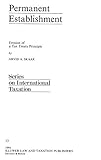Permanent establishment : Erosion of a tax treaty principle
Publication details: Austin Kluwer Law International 1991Description: 604p xliISBN:- 9789065445940
- 343.040000 SKA
| Item type | Current library | Call number | Status | Date due | Barcode |
|---|---|---|---|---|---|
 BOOKs
BOOKs
|
National Law School | 343.04 SKA (Browse shelf(Opens below)) | Not For Loan | 24046 |
Contents:
PART ONE: INTRODUCTION –
Introduction;
1 Preliminary issues --
2 Some constitutive political and economic elements of international society --
3 Theories on allocation of international taxing jurisdiction --
4 Main elements in a tax-treaty policy on PE: Basic contradictions --
5 Methodolofy: Sources of international fiscal law --
6 General historical background: An overview --
7 The history of the concept of PE --
8 Classification of PE conditions --
PART TWO: THE BASIC RULE --
A THE OBJECTIVITY OF THE PE --
9 The taxpayer's physical presence: The "place of business test" --
10 Physical presence at a specific place: The "location test" --
B THE SUBJECTIVITY OF THE PE --
11 The right to use the place of business: The "right of use test" --
12 The "right of use test" for profit-sharing arrangements. 13 The "right of use test" and arm's-length business connections --
14 Indirect evidence of a right of use to a place of business --
15 The duration of the right to use the place of business: The "permanence test" --
C THE FUNCTIONALITY OF THE PE --
16 Introduction --
17 Business activities excluded in the treaties --
18 The domestic-law aspect: Income-generating activities distinguished from "business" in the treaties --
19 Core business activity or auxiliary of preparatory activities? The tax-treaty aspect of the concept of "business" --
20 The connection between the business and the place of business: The "business connection test" --
PART THREE: CONSTRUCTION WORK --
21 Introduction: The construction clause and its relationship to the basic rule. 22 The objectiviry of the construction PE: Identification --
23 The subjectivity of the construction PE: The "duration test" --
24 The functionality of the construction PE: The "business activiry test" --
PART FOUR: OFFSHORE BUSINESS ACTIVITIES --
25 Introduction --
26 Outline of offshore PE fictions --
27 Offshore identification provisions in the tax treaties between Norway and the US, the UK, France, and the Nordic states --
28 The "business activity test" of the offshore clause --
PART FIVE: AGENCIES --
29 Introduction --
30 Main trends in the development of the agency clause --
31 The agent and the authorization: The objectivity of the agency PE --
32 "Legal" or "commercial" dependence: The subjectivity of the agency PE. 33 Deemed dependency: The "ordinary course of business test" --
34 The functionality of the agency PE --
35 UN model treaty deviations from the OECD agency clause --
PART SIX: SUBSIDIARY AS PE --
36 PE through related corporations --
PART SEVEN: SUMMARY AND CONCLUSIONS --
37 Summary and conclusions;
Bibliography;
Table of cases;
Official documents;
Index.

There are no comments on this title.